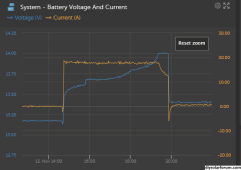Can someone help me understand why Battle Born batteries in parallel require 30 minutes of absorb per battery and why not 30 min of absorb per parallel string (especially since the whole bank is only accepting a few amps at most during this time)?
Is absorb phase the same as balancing phase?
Also, the manual that came with my batteries over a yea ago (Battle Born Batteries BB5024 Manual) says the above. A more recent manual (Edition.PIM_BB5024Rev018_09062022) instructs , regarding absorb time, “Two batteries in parallel connections require 30 minutes 100ah”. WTF does that imply? Who is writing this shit? Or am I a total idiot?
Is absorb phase the same as balancing phase?
Also, the manual that came with my batteries over a yea ago (Battle Born Batteries BB5024 Manual) says the above. A more recent manual (Edition.PIM_BB5024Rev018_09062022) instructs , regarding absorb time, “Two batteries in parallel connections require 30 minutes 100ah”. WTF does that imply? Who is writing this shit? Or am I a total idiot?







